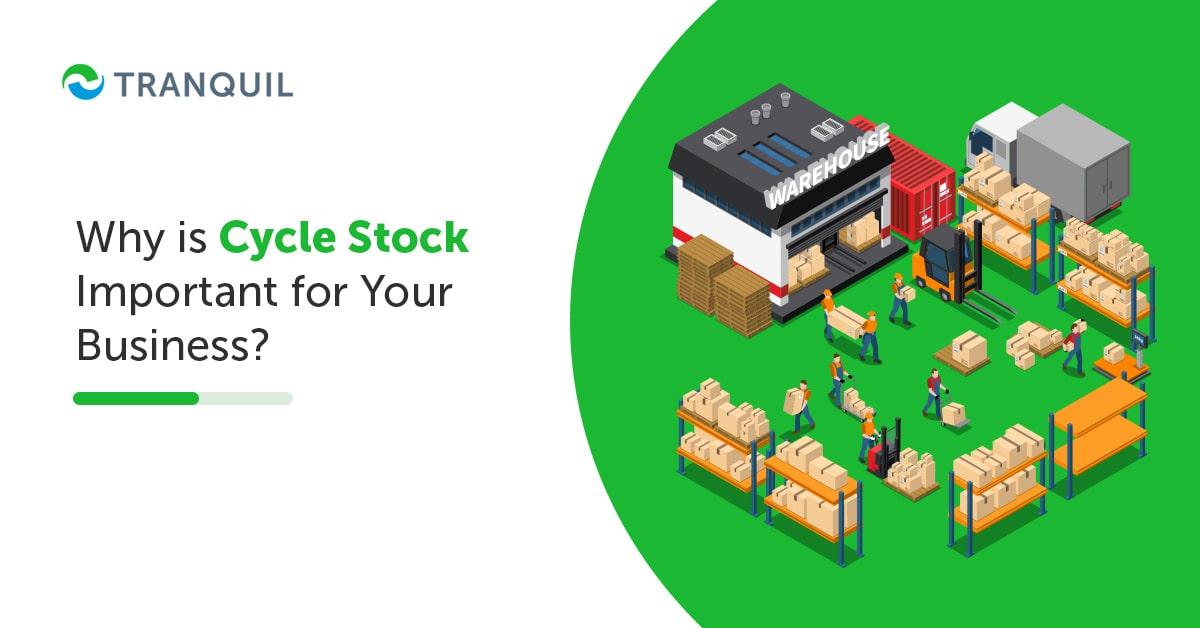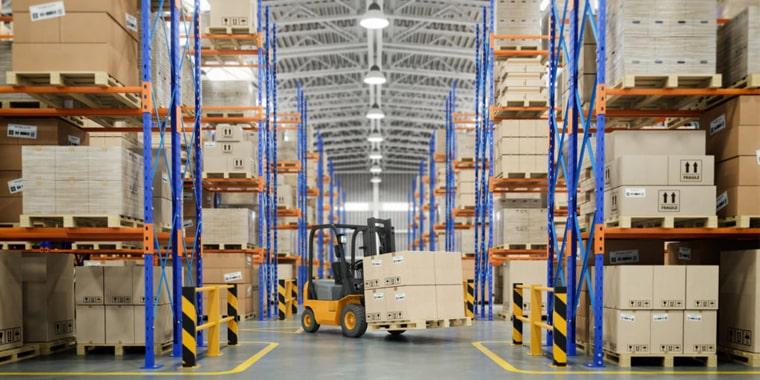
Why is Cycle Stock Important for Your Business?
It is extremely important for any business to hold sufficient inventory to be able to fulfil customer demands, and bring in revenues; in fact, a business must have adequate inventory to meet the projected demand and have a buffer of extra stock so that unforeseen problems like delayed deliveries by vendors or sudden demand surges can be handled.
Cycle stock is a critical element of inventory management.
It is essential that you understand cycle stock inventory and the quantity required to have on hand over a specific time will allow you to fulfil customer demands without increasing costs.
ALSO READ: Tips For Efficient Stocktaking
What Is Cycle Stock?
Cycle stock is the quantity of inventory that is available to fulfil the usual demand in a given time and is also called working inventory.
This is the inventory level you normally expect to have after checking both historical data and forecasts.
It is just a part of your total inventory on hand and will have to be replaced as your products get sold.
Safety Stock Vs Cycle Stock

Both basically differ depending on the expected use for each inventory type.
While cycle stock refers to the inventory set aside to fulfil normal customer demand in a given time period, safety stock is akin to your backup, or buffer inventory.
It is the stock of products maintained in your warehouse to meet unforeseen demand spikes, delayed or inadequate production, and so on.
Let’s say that you run a massive campaign for the festival season, and it is hugely successful.
Your company has bumper sales, far outperforming the sales of the previous year, and the current projection by a huge margin.
It is highly likely that your cycle stock will be quickly depleted; you will then have to fall back on your safety stock.
In the absence of that buffer you keep for just these kinds of events, you will likely lose potential sales and customers – who may not give you another chance and take their business elsewhere for good.
But in case the forecast of sales is bang on, or unfortunately, the customer demand is not as per the forecasted sales, you can meet it from your regular cycle stock.
This is why deciding the ideal cycle stock is a dicey thing.
It’s a balancing act that companies have to do – overstocking can cause its own share of problems.
The formula for cycle stock calculation is simple: Total inventory on hand – Safety stock = Cycle stock.
ALSO READ: What is Negative Inventory?
What is the Importance of Cycle Stock in Business?
Cycle stock is crucial in a business, as it is used to ensure sales orders are completed.
Without sufficient inventory to fulfil customer demands, a business is likely to fail; customers today are demanding, and not willing to go back to any business where they don’t get a good experience the first time.
Having adequate stock on hand is important for cash flow generation because cash comes in when a business sells products and gets the money.
The goods that get sold have to be replenished, and so the company places orders with different vendors, using the cash from the cycle stock sales to make payments.
Managing Cycle Stock Inventory

This task becomes easier once you have historical sales data to check and are able to pick out sales trends, as well as make accurate forecasts.
Once you get this right, you can make sure that you have the right inventory available and replenished in time to keep the business flow smooth.
In the initial stages of the business, it can be difficult to predict the cycle stock level you may require – there is no historical data to depend on!
In such cases, consult business experts so that you get a clear picture, check out what the competition is doing, and make educated guesses about the seasonal demands, the effect of promotions, and check current market trends to arrive at a figure.
When you have sufficient historical information to work with, you can create demand forecasts that are more in-depth and dependable.
You will begin to get an idea of sales fluctuations in the year, which products sell quickly and which are slow, and so on.
Inventory management modules which are part of robust ERP solutions like Tranquil can be very valuable, as they can make accurate sales forecasts with the help of seasonality, trends, historical data and additional factors.
The main point is that you need to have sufficient cycle stock so that it will last till you receive the new purchase order at the store, factory, or warehouse.
Generally, the time gap between order receipts or between two manufacturing runs (in factories) is considered as the time period to calculate the cycle stock.
In an ideal situation, you would have sold almost all of the cycle stock, before new stocks arrive from the vendor or from your plant.
ALSO READ: ERP software in Warehouse & Fixed Asset Management
Benefits of Forecasting Cycle Stock
Forecasts are the base on which the right quantity of cycle stock to have, is determined.
These are the main benefits you get from forecasting:
1. Optimize Revenue
When you receive payment for goods sold, you get the money to buy new raw materials or products, and meet your other expenses; the greater the sales of cycle stock, the more the revenue generation, and the more the business growth.
2. Fulfil Customer Demand
Cycle stock helps a business to meet the customer demands immediately, and without this stock, you can lose sales, and end up with unhappy customers, which impacts their loyalty.
They will simply look for another brand, or store with similar products.
With proper forecasting of cycle sales, you will have fewer lost sales
ALSO READ: VAN Sales and Route Sales
3. Save Costs
While lower inventory means lower carrying costs, being stocked out can lead to even more expensive with urgent shipping and rush order fees for sudden reordering.
4. Business Performance Insights
How your cycle stock levels change over time can indicate how well or otherwise your business is performing, as it is a direct reflection of sales.
If the cycle stock is progressively increasing, it means the customer demand is high for that product; if the cycle stock levels decrease, then the opposite is true.
5. Lower Inventory Costs
Forecasts also make sure that you don’t overstock on inventory, thereby saving you from spending high amounts on carrying costs.
When you have the ideal quantity, you will sell them in a decent amount of time, and get in fresh goods.
ALSO READ: How ERP Can Improve Business Efficiency?
6. Conserve Safety Stock
Without adequate cycle stock, you will go through your safety stock regularly and this is not a good sign for a business; safety stock is only to be used for major events, like unprecedented demands, natural disasters, supplier shut down and so on.
7. Avoid Emergency Purchases
If you keep getting stock out of certain products you will rush to purchase additional products from your vendors, and you may have to pay a lot more to get them to your facility quickly – rush shipments always cost more.
You may have to find other vendors who supply the same products but they may charge you more.
This can be avoided with forecasts.
ALSO READ: Challenges in Procurement and Supply Chain
Cycle Stock Inventory Accounting

Cycle stock brings in revenues, and hence cash into the business, and this is a most important feature.
A company’s inventory is an asset, and so is mentioned in the balance sheet.
Companies use different methods to determine COGS or the cost of goods sold for inventory.
The method of inventory costing you select can impact the COGS as prices keep varying, and hence the gross profit is also impacted.
Here are some common methods:
- FIFO or First In First Out: The inventory cost depends on the price of the oldest items purchased
- LIFO or Last In First Out: The cost depends on the price of the latest items purchased
- WAC or Weighted Average Cost: this method just uses the average purchase price of all the inventory sold.
ALSO READ: Benefits of ERP in Accounting and Financial Management
Calculating Cycle Stock with EOQ
Now we come to the issue of how to calculate the size of the cycle stock order.
Most businesses use the EOQ or economic order quantity formula, which enables businesses to order sufficient stocks to fulfil demand while keeping the per-order costs low.
You have to think about the cost of ordering, holding, and the demand for the product when you calculate EOQ.
Q = √ (2 x D x S / H) This is the formula for the calculation, where Q is the quantity per order, D is the annual demand, S is the cost of the purchase, and H is the holding cost for a unit
ALSO READ: What is Job Costing?
Cycle Stock Inventory in Supply Chain Management

Cycle stock comprises a major part of the complete supply chain management strategy of a business. Having an optimal inventory level available includes ordering with the right vendors at the appropriate time, and allowing for the speed at which you can sell products.
It can be very complicated to arrive at the best way to ensure your strategy succeeds.
No wonder businesses focus a lot on SCM nowadays.
Let us say that your cycle stock requirement goes up to 2000 from 1000 because of a successful marketing promotion you ran; your current vendor may not be capable of supplying the extra 1000 units, so now you have to find another vendor who can.
What if the projection is that this year a particular item will sell 3x more than the previous year, and you can see a steady increase in the demand for that product?
You not only have to find vendors who will be able to supply the product, you have to check if your shipping and delivery partners are able to handle that kind of volume; if they can, will they offer lower rates?
If they cannot, you may have to find additional shippers.
So, you can see that it’s complicated, and you need to consider all of these factors to track cycle stock and make adjustments.
ALSO READ: Comparison of Sales Orders and Purchase Orders
Are you unsure of how to keep track of your inventory properly and how you can calculate your safety stock and cycle stock properly? The Inventory management module in Tranquil ERP can do all this and more. It is integrated with other modules that help you streamline the functions of purchase management, finance management, HR, and more. Do schedule a demo with us to see for yourself how it works and our team will be there to explain how it benefits your business.



